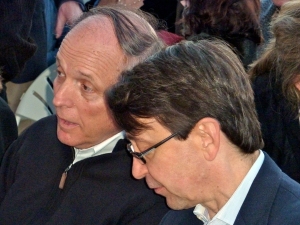A Placemaking Journal
The Revolution Will Not be Organized (But the food and drink will be pretty good)
 It’s officially over.
It’s officially over.
The flush era for planners and designers, when utopian villages and new towns could grow from dreams and piles of private sector cash? Long gone. Now comes the revolution.
What the revolt will look like is under debate. And not surprisingly, the most intense discussions are joined by those who have always been arguing about one thing or another, even as they designed and built places that, at least in part, defined neighborhood and community character during the flush times.

Dhiru Thadani, making copies of his book even more valuable. A feat no one thought possible.
Okay, maybe “impoverished” is not exactly the right word, said Andres. “We’re not poor, just no longer hideously wealthy.” But one thing for sure, he said: “The 20th century ended in 2010.”

Stefanos Polyzoides, left, pictured with Hank Dittmar of the Prince's Foundation for the Built Environment.
What’s more, said Stef, himself a beloved member of the old guard of New Urbanism, it’s time for the old guard to step aside. He proposed that for the 20th anniversary of the Congress for the New Urbanism no one over 50 years of age be allowed to participate in the annual event. Andres then upped the ante by suggesting that the age limit be lowered to 40.
That was pretty much the drift of the discussion through two invigorating forums over two days. Part Ivy League honors class and part New England town meeting. In between and after, as usual, everybody moved somewhere to eat spectacular food and drink good wine. (Will the revolution be catered?)
The ritual debate was leavened by the presence of Shelley Poticha, a former CNU executive director and now head of HUD’s Office of Sustainable Housing and Communities.
[youtube=http://www.youtube.com/watch?v=VPhdu8JVvJc]There are indeed tough times ahead, Shelley told the forum audience. But it’s also good to remember that the work New Urbanists have done to advance the cause of compact, walkable, mixed-use communities has paid dividends. Core principles of the New Urbanist effort now permeate the highest policy-making offices in Washington. And even if they don’t call themselves New Urbanists and even if they don’t yet know a transect zone from no parking zone, “there are people absolutely everywhere,” said Shelley, who’ve become advocates of repairing and rebuilding communities according to those principles.
“They may not yet have the skills,” said Shelley, “but they understand. . . They are already there, and they are open” to approaches tested and refined by Smart Growth/New Urbanist advocates. The challenge will be to “start where people are at” and not necessarily where New Urbanists insist they be. Which is a revolutionary concept if ever there was one.
It’s a good time, said Shelley, “to use our skills in strategic ways” to keep the conversation going and to facilitate the transformation of communities. To that end, what do you think? How do we move, as Shelley asks, “from this desire — this vision — to actual change on the ground?”
–Ben Brown


